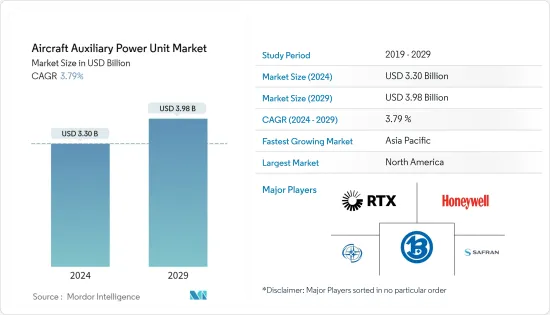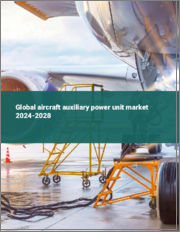
|
시장보고서
상품코드
1438422
세계 항공기용 보조동력장치 시장 : 점유율 분석, 업계 동향과 통계, 성장 예측(2024-2029년)Aircraft Auxiliary Power Unit - Market Share Analysis, Industry Trends & Statistics, Growth Forecasts (2024 - 2029) |
||||||
항공기용 보조동력장치 시장 규모는 2024년 33억 달러로 추정되고, 2029년까지 39억 8,000만 달러에 이를 것으로 예측되며, 예측 기간 동안 복합 연간 성장률(CAGR) 3.79%로 성장할 전망입니다.

COVID-19의 유행은 항공기용 보조동력장치 시장에 악영향을 미쳤습니다. 유행 기간 동안 세계 여객 여행의 감소로 새로운 민간 항공기 및 일반 항공 항공기 수요가 감소했습니다. 또한 보조 전원 공급 장치 제조에 필요한 주요 구성요소 운송에 대한 공급망의 한계도 시장에 영향을 미쳤습니다. 그럼에도 불구하고 일부 항공사가 항공기 납품과 새로운 항공기 주문을 재개했기 때문에 여객 운송량이 증가함에 따라 2021년에 상황이 개선되었습니다. COVID-19에 의한 군용기의 납품에 대한 영향은 중대했습니다. 생산 및 납품 일정이 지연되어 2022년 이후 항공기 제조업체는 다양한 군용기의 수주 잔여물을 보충하고 신속하게 납품하는 데 중점을 두고 있습니다. 2022년 에어버스와 Boeing은 전 세계 최종 사용자에게 1,156대의 항공기를 납품하고, 에어버스는 676대의 납품을 차지하고 나머지는 Boeing이 차지했습니다.
연료 효율이 높고 소음이 적고 이산화탄소 배출량이 적은 항공기를 제조할 필요성으로 향후 수년간 APU 기술의 연구개발이 촉진될 수 있습니다. 항공기의 전기 아키텍처가 증가함에 따라 전체 전기 APU의 개발이 수년에 걸쳐 증가했습니다. 이러한 전기 APU를 사용하는 이점은 향후 시장에 추가 성장 기회를 제공할 수 있습니다.
항공기용 보조동력장치(APU) 시장 동향
민간 항공 부문은 시장에서 최고의 점유율을 유지
현재 상용 부문은 항공기용 보조동력장치 시장에서 최고 시장 점유율을 자랑합니다. 연료효율 향상, 배출가스 절감, 작동음 조용화 등으로 이어지는 APU의 기술진보는 상업시장의 성장에 기여하는 요인으로는 거의 없습니다. 게다가 승객의 쾌적성과 안전성이 중시되어 APU 수요가 높아지고 있습니다. 항공사는 전반적인 승객 경험을 개선하고 시장에서 경쟁력을 유지하기 위해 고품질 APU에 대한 투자를 늘리고 있습니다.
예를 들어, Honeywell은 2023년 5월 말레이시아 신흥기업 MYAirline에서 항공사 에어버스 A320에 탑재된 보조 전원 공급 장치(APU)를 지원하는 계약을 획득했습니다. 이 계약에는 22대의 131-9A APU가 포함됩니다. 또한 2022년 7월 휘트니 앤 플랫 캐나다는 터키시 에어라인과 8년간의 유지보수 및 장비 개선 계약을 체결했습니다. 이 계약에는 이 회사의 에어버스 A320형기에 탑재되는 82대의 APS3200 보조 전원 장치(APU)가 포함됩니다. 이러한 개발과 항공사로부터의 APU 설치 계약 증가는 예측 기간 동안 부문의 성장을 추진합니다.
아시아태평양은 예측기간 동안 최고의 성장을 이
중국, 인도, 일본 등 주요 국가의 여객 운송량이 급증함에 따라 아시아태평양에서 운항하는 항공사의 신규 항공기 주문 수요가 증가하고 있습니다. 새로운 항공기 주문에 대한 수요 증가로 인해 이 지역의 항공기용 보조동력장치 시장이 견인될 것으로 예상됩니다. 또한 아시아태평양의 국가들은 현재 항공기재의 현대화에 많은 투자를 하고 있습니다. 2022년에 에어 버스는 676대, Boeing은 480대를 납품했습니다. 세계적으로 볼 때 아시아는 가장 많은 항공기를 주문하고 시장을 선도하고 있으며 중국에서 대량 주문을 볼 수 있습니다. 인도의 LCC인 인디고 항공은 에어버스에 비해 가장 큰 단일 주문 잔고를 보유하고 있습니다.
군용항공 분야에서는 구형 항공기의 업그레이드에 따른 국방비 증가로 군용기의 조달이 급증하여 항공기용 보조동력장치 수요를 보완할 것으로 예상됩니다. 이러한 모든 요인들은 예측 기간 동안 아시아태평양에서 항공기용 보조동력장치에 대한 수요가 발생할 것으로 예상됩니다.
항공기용 보조동력장치(APU) 산업 개요
시장은 고도로 통합되어 있으며 주요 시장 점유율을 얻는 기업은 거의 없습니다. Honeywell International Inc., JSC NPP Aerosila, Prat and Whitney(Raytheon Technologies Corporation), PBS Group, as, Safran은 현재 시장의 주요 기업의 일부입니다. 민간 항공 부문에서 플랫 앤 휘트니와 Honeywell은 에어버스와 Boeing의 항공기용 보조동력장치에 대한 수요가 많아 과반수 점유율을 독점하고 있습니다. 군용 항공 부문은 항공기용 보조동력장치 제조업체에게 새로운 기회를 가져올 것으로 예상되며 시장 경쟁이 심화될 수 있습니다. 전동 APU 등의 신기술의 이용과, 보다 전기적인 아키텍쳐를 갖춘 차세대 항공기에 대응하는 준비를 마련하기 위한 대처에 의해 예측 기간 중에 항공기용 보조동력장치 시장의 경쟁 기업간의 적대 관계가 격화 수 있습니다.
기타 혜택
- 엑셀 형식 시장 예측(ME) 시트
- 3개월의 애널리스트 서포트
목차
제1장 서론
- 조사의 전제조건과 시장의 정의
- 조사 범위
제2장 조사 방법
제3장 주요 요약
제4장 시장 역학
- 시장 성장 촉진요인
- 시장 성장 억제요인
- 업계의 매력 - Porter's Five Forces 분석
- 신규 진입업자의 위협
- 구매자의 협상력
- 공급기업의 협상력
- 대체 제품의 위협
- 경쟁 기업간 경쟁 관계의 격렬
제5장 시장 세분화
- 플랫폼별
- 상용
- 좁은 바디 항공기
- 와이드 바디 기계
- 지역 제트
- 군
- 전투
- 특별 임무
- 수송/탱커
- 연습기
- 무인 항공기(UAV)
- 일반항공
- 경비행기
- 비즈니스 제트
- 헬리콥터
- 상용
- 항공기 유형별
- 고정날개
- 회전익
- 지역별
- 북미
- 미국
- 캐나다
- 유럽
- 영국
- 프랑스
- 독일
- 러시아
- 이탈리아
- 기타 유럽
- 아시아태평양
- 중국
- 인도
- 일본
- 호주
- 기타 아시아태평양
- 라틴아메리카
- 브라질
- 멕시코
- 기타 라틴아메리카
- 중동 및 아프리카
- 아랍에미리트(UAE)
- 사우디아라비아
- 이집트
- 기타 중동 및 아프리카
- 북미
제6장 경쟁 구도
- 벤더의 시장 점유율
- 기업 프로파일
- Honeywell International Inc.
- JSC NPP Aerosila
- Pratt &Whitney(Raytheon Technologies Corporation)
- Safran
- Technodinamika(Rostec)
- PBS Group, as
- Motor Sich JSC
- AEGIS Power Systems Inc.
- Rolls-Royce plc
- Eaton Corporation plc
제7장 시장 기회와 미래 동향
BJH 24.03.11The Aircraft Auxiliary Power Unit Market size is estimated at USD 3.30 billion in 2024, and is expected to reach USD 3.98 billion by 2029, growing at a CAGR of 3.79% during the forecast period (2024-2029).

The COVID-19 pandemic adversely impacted the aircraft auxiliary power unit market. During the pandemic, the demand for new commercial and general aviation aircrafts declined due to a reduction in passenger travel globally. In addition, the supply chain restrictions for the transportation of key components required to manufacture auxiliary power units impacted the market. Nevertheless, the situation improved in 2021 with the increase in passenger traffic, as several airlines resumed taking aircraft deliveries and ordering new aircraft. The COVID-19 impact on military aircrafts deliveries was significant. Delays in production and delivery scedules occured, since 2022, aircraft manufacturers have empahised on covering backlog and fast deliveries of various military aircrafts. During 2022, Airbus and Boeing delivered 1,156 aircraft to global end users, wherein Airbus accounted for 676 aircraft deliveries while Boeing accounted for the rest.
The need to produce aircraft with high fuel efficiency, less noise, and carbon emissions may drive the research and development of APU technologies in the years to come. With more electric architecture in aircraft, the development of all-electric APUs increased over the years. The benefits of using these electric APUs may provide further growth opportunities for the market in the future.
Aircraft Auxiliary Power Unit (APU) Market Trends
Commercial Aviation Segment Holds Highest Shares in the Market
Currently, the commercial segment has the highest market share in the aircraft auxiliary power unit market. Technological advancemnets in APUs which lead to improved fuel effiecncy, reduced emissions, and quieter operations are few factors contributing to the growth of commercial market. Furthermore growing emphasis on passenger comfort and safety is driving the demand for APUs. Airlines are increasingly investing in high-quality APUs to enhance the overall passenger experince and maintain the competitive edge in the market.
For instance, in May 2023, Honeywell has secured a contract from Malaysian Startup MYAirline to support auxillary power units (APUs) installed on the carrier's Airbus A320s. The agreement covers 131-9A APUs for 22 jets. Also, in July 2022, Whitney & Pratt Canada signed an eight-year maintenance and fleet improvement deal with Turkish Airlines. The deal includes the 82 APS3200 auxiliary power units (APUs) on the airline's fleet of Airbus A320 planes. Such developments and rising APUs installation contracts from airlines drive the growth of the segment during the forecast period.
Asia-Pacific to Experience the Highest Growth During the Forecast Period
The rapid increase in the passenger traffic of major countries like China, India, and Japan is driving the demand for several new aircraft orders from airlines operating in the Asian-Pacific region. The increasing demand for new aircraft orders is expected to drive the aircraft auxiliary power units market in this region. Additionally, countries in Asia Pacific region are investing heavily in modernizing their current aviaiton fleet. In 2022, Airbus delivered 676 aircraft, and Boeing delivered 480. Globally, Asia leads the market with the most orders for aircraft, with bulk orders from China. Indigo Airlines, an Indian LCC, has the largest single-order backlog with Airbus.
In military aviation, the rise in defense expenditure for the up gradation of old aircraft fleets is expected to surge the procurement of military aircraft and supplement the demand for aircraft auxiliary power units. All these factors are expected to generate demand for aircraft auxiliary power units in the Asia-Pacific region during the forecast period.
Aircraft Auxiliary Power Unit (APU) Industry Overview
The market is highly consolidated with few players grabbing a major market share. Honeywell International Inc., JSC NPP Aerosila, Pratt and Whitney (Raytheon Technologies Corporation), PBS Group, a. s., and Safran are currently some of the major players in the market. In the commercial aviation segment, the companies Pratt & Whitney and Honeywell dominate a majority share with their well-established demand for aircraft auxiliary power units from Airbus and Boeing. The military aviation sector is expected to open new opportunities for aircraft auxiliary power unit manufacturers and can register increased competition in the market. The utilization of new technologies, such as electric APUs, and work in this regard so that they may get ready to cater to the next-generation aircraft with more electric architecture may increase the competitive rivalry in the aircraft auxiliary power unit market during the forecast period.
Additional Benefits:
- The market estimate (ME) sheet in Excel format
- 3 months of analyst support
TABLE OF CONTENTS
1 INTRODUCTION
- 1.1 Study Assumptions and Market Definition
- 1.2 Scope of the Study
2 RESEARCH METHODOLOGY
3 EXECUTIVE SUMMARY
4 MARKET DYNAMICS
- 4.1 Market Drivers
- 4.2 Market Restraints
- 4.3 Industry Attractiveness - Porter's Five Forces Analysis
- 4.3.1 Threat of New Entrants
- 4.3.2 Bargaining Power of Buyers/Consumers
- 4.3.3 Bargaining Power of Suppliers
- 4.3.4 Threat of Substitute Products
- 4.3.5 Intensity of Competitive Rivalry
5 MARKET SEGMENTATION
- 5.1 By Platform
- 5.1.1 Commercial
- 5.1.1.1 Narrow-body Aircraft
- 5.1.1.2 Wide-body Aircraft
- 5.1.1.3 Regional Jet
- 5.1.2 Military
- 5.1.2.1 Combat
- 5.1.2.2 Special Mission
- 5.1.2.3 Transport/Tanker
- 5.1.2.4 Trainer Aircraft
- 5.1.2.5 Unmanned Aerial Vehicles (UAVs)
- 5.1.3 General Aviation
- 5.1.3.1 Light Aircraft
- 5.1.3.2 Business Jets
- 5.1.3.3 Helicopters
- 5.1.1 Commercial
- 5.2 By Aircraft Type
- 5.2.1 Fixed-Wing
- 5.2.2 Rotary-Wing
- 5.3 By Geography
- 5.3.1 North America
- 5.3.1.1 United States
- 5.3.1.2 Canada
- 5.3.2 Europe
- 5.3.2.1 United Kingdom
- 5.3.2.2 France
- 5.3.2.3 Germany
- 5.3.2.4 Russia
- 5.3.2.5 Italy
- 5.3.2.6 Rest of Europe
- 5.3.3 Asia-Pacific
- 5.3.3.1 China
- 5.3.3.2 India
- 5.3.3.3 Japan
- 5.3.3.4 Australia
- 5.3.3.5 Rest of Asia-Pacific
- 5.3.4 Latin America
- 5.3.4.1 Brazil
- 5.3.4.2 Mexico
- 5.3.4.3 Rest of Latin America
- 5.3.5 Middle-East and Africa
- 5.3.5.1 United Arab Emirates
- 5.3.5.2 Saudi Arabia
- 5.3.5.3 Egypt
- 5.3.5.4 Rest of Middle-East and Africa
- 5.3.1 North America
6 COMPETITIVE LANDSCAPE
- 6.1 Vendor Market Share
- 6.2 Company Profiles
- 6.2.1 Honeywell International Inc.
- 6.2.2 JSC NPP Aerosila
- 6.2.3 Pratt & Whitney (Raytheon Technologies Corporation)
- 6.2.4 Safran
- 6.2.5 Technodinamika (Rostec)
- 6.2.6 PBS Group, a. s.
- 6.2.7 Motor Sich JSC
- 6.2.8 AEGIS Power Systems Inc.
- 6.2.9 Rolls-Royce plc
- 6.2.10 Eaton Corporation plc

















